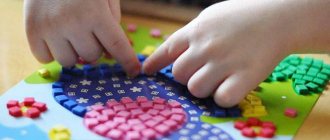Why is the mushroom exercise so important in correcting speech defects?
In this article I will tell you how the tongue exercise “Mushroom” and massage of the speech organs to produce some sounds will help you. There comes a time for all children when they start talking. Of course, this is the most important period in speech development. Normally, a child begins to speak at ten months. Diction disorders become more noticeable by the age of two, when the baby tries to find the correct syllables, combining them into words.
If a child is unable to correctly pronounce sounds, syllables, words and phrases, then the cause may be problems in the structure of the organs of articulation, for example, reduced mobility of the tongue. This is where parents should be wary if speech is slurred, hissing sounds and the “r” sound are missing or severely distorted. The baby faces difficulties in communication, spelling, decreased self-esteem and self-confidence.
Exercises to normalize breathing function
Exercise No. 1 Full breathing. Take a long breath through your nose. During inhalation, the abdomen “inflates”, then the chest expands. When you exhale (through the nose), on the contrary, the volume of the chest first decreases, then the stomach retracts.
Exercise No. 2 Chest breathing. Exhale. Take a long breath through your nose. At this time, the chest expands and the stomach retracts. When you exhale (through the nose), the stomach retracts.
Exercise No. 3 Abdominal breathing. Exhale. Take a long breath through your nose. At this time, the stomach protrudes. When you exhale (through the nose), the stomach retracts.
Exercise No. 4 The skill of full, extended exhalation. Walk at an average pace. Inhale and exhale only through the nose. Inhale for three steps, exhale for four steps. After three to four days, the duration of exhalation should be increased by one count (5,6, etc.)
Exercise No. 5 Inhale and exhale alternately through one nostril (press the second nostril tightly with your finger).
Exercises to train the muscles of the tongue and normalize the type of swallowing
Exercise No. 1 “Clock”. The mouth is open, the tongue makes slow circular movements along the upper lip, then along the lower lip.
Exercise No. 2 “Punish the naughty tongue.” Place your tongue on your lower lip and slap it with your upper lip “na-na.”
Exercise No. 3 “We will paint the ceiling.” It's time to paint the rooms, they invited a molar, he comes to the old house with a new brush and bucket. Your tongues are a brush, your hard palate is the ceiling...
Exercise No. 4 Depict the operation of a jackhammer. DDDD...
Exercise No. 5 “Riders”. Sit astride a chair and, opening your mouth wide, click your tongue.
How to teach a child to say R: we train hard
Your primary task is to help your baby strengthen his tongue muscles. There is a set of exercises for this.
The lesson can be based on the fairy tale about the Merry Tongue. The mouth is the house, the hard palate is the ceiling.
If the question “How to teach a child to say R?” is acute in your family, start training by remembering a few simple rules.
- Your motto is patience.
If parental insistence is accompanied by a nervously twitching eye and crimson cheeks, postpone classes. You shouldn’t blame the baby for not demonstrating the wonders of articulatory acrobatics the first time.
vggu.ru
- Do not forget that the leading activity of preschoolers is play.
Conduct classes in front of a large mirror. This way the baby will be able to control his movements.
- Only systematic training guarantees results.
Therefore, we recommend that you stick to a home schedule.
Exercises to normalize breathing function
Exercise No. 1 Full breathing. Take a long breath through your nose. During inhalation, the abdomen “inflates”, then the chest expands. When you exhale (through the nose), on the contrary, the volume of the chest first decreases, then the stomach retracts.
Exercise No. 2 Chest breathing. Exhale. Take a long breath through your nose. At this time, the chest expands and the stomach retracts. When you exhale (through the nose), the stomach retracts.
Exercise No. 3 Abdominal breathing. Exhale. Take a long breath through your nose. At this time, the stomach protrudes. When you exhale (through the nose), the stomach retracts.
Exercise No. 4 The skill of full, extended exhalation. Walk at an average pace. Inhale and exhale only through the nose. Inhale for three steps, exhale for four steps. After three to four days, the duration of exhalation should be increased by one count (5,6, etc.)
Exercise No. 5 Inhale and exhale alternately through one nostril (press the second nostril tightly with your finger).
Exercise No. 6 Exhale. Pinch your nose with your fingers. Slowly count out loud to 5, then take a deep breath and exhale through your nose.
Exercises to strengthen the pharyngeal muscles
Exercise No. 1 Alternately tilt your head back as much as possible, leaning forward.
Exercise No. 2 Throw your head back. In this position, alternately tilt your head towards the right and left shoulder.
Exercise No. 3 Throw your head back, in this position alternately turn your head, without releasing your chin, to the right, then to the left.
Breathing exercises in speech therapy
Training the articulatory organs and the development of speech breathing is one of the main points in the structure of speech correction classes with children who have defects in the pronunciation of sounds. Articulation and breathing exercises play a particularly important role in the correction of dysarthria. Speech therapists at the Yusupov Hospital consistently use various types of gymnastics. First, general motor exercises are performed, followed by breathing exercises, then vocal exercises, and only at the end articulation exercises.
Breathing exercises begin with general breathing exercises. Their goal is to increase breathing volume and normalize its rhythm. The patient is taught to breathe with his mouth closed. They train nasal exhalation by telling the baby: “Inhale deeply and exhale for a long time through the nose.” Then they practice mouth exhalation, while closing his nostrils. Exercises with resistance are used when the speech therapist places his hands on the chest, as if preventing inhalation for 1-2 seconds. They teach you to hold your breath, achieving a deep, quick inhalation and a slow, long exhalation.
Breathing exercises are performed using game techniques. “Bubbles” – use a straw and a glass of water. The speech therapist pays attention to the fact that the exhalation is long, that is, the bubbles should “come out” for a long time.
It is fashionable to use all kinds of whistles and pen caps for children's musical instruments.
“Focus” is an exercise with a piece of cotton wool that prepares you for pronouncing the sound [r]. The speech therapist places cotton wool on the tip of the nose. The patient is asked to stretch out his tongue, bend its tip up and blow on the cotton wool to blow it off the nose.
You can suggest blowing on the flame of a burning candle so as not to blow it out, but only slightly deflect the flame. You should blow carefully, slowly, for a long time. The same exercise is used when producing whistling and hissing sounds.
Exercises to normalize the function of lip closure
Exercise No. 1 Pull your lips forward, close them, draw a tube, and stretch them wide.
Exercise No. 2 Pull your lips forward, close them, depict a mouthpiece, a proboscis.
Exercise No. 3 Close your lips, puff out your cheeks, slowly squeeze the air through your clenched lips with your fists.
Exercise No. 4 Close your lips, then move them alternately to the right and left.
Exercise No. 5 Close your lips, blow air under your upper lip, then under your lower lip.
Exercise No. 6 Place bent little fingers in the corners of the mouth, do not close your lips, spread your fingers slightly to the sides, close your lips.
Exercise No. 7 Blow out a stream of air with force (“a breeze is blowing,” let’s put out the candle,” “let’s make a storm,” etc.).
Exercises to train the muscles of the tongue and normalize the type of swallowing
Exercise No. 1 “Clock”. The mouth is open, the tongue makes slow circular movements along the upper lip, then along the lower lip.
Exercise No. 2 “Punish the naughty tongue.” Place your tongue on your lower lip and slap it with your upper lip “na-na.”
Exercise No. 3 “We will paint the ceiling.” It's time to paint the rooms, they invited a molar, he comes to the old house with a new brush and bucket. Your tongues are a brush, your hard palate is the ceiling...
Exercise No. 4 Depict the operation of a jackhammer. DDDD...
Exercise No. 5 “Riders”. Sit astride the toilet seat and, opening your mouth wide, click your tongue.
Exercise No. 6 Lift the tongue up, press it to the front part of the hard palate in the area of the palatine folds. Clench your teeth, swallow saliva, fixing the position of your tongue.
Exercise No. 7 Raise the tip of the tongue up and place it at the anterior part of the hard palate. Move the tongue along the arch of the hard palate as far back as possible to the soft palate.
Exercise No. 8 Raise the tip of the tongue up and place it at the anterior part of the hard palate. Move your tongue along the palatal surface of the teeth on the right and left, touching each tooth.
The Tale of Little Mushroom
Once upon a time there lived a small mushroom in a pine forest. And he really wanted to grow up quickly, but didn’t know how. There were rumors in the forest about the old and wise old man Borovichka. The fungus went on a search. For several days and nights he walked through the forest, asking all the mushrooms he encountered along the way. Unfortunately, no one knew where the old man lived. Coming out to the edge of the forest, an old man named Borovichok sat near a tall spruce tree on the sun-warmed grass.
Mushroom was delighted and ran as fast as he could towards him. Mushroom asked how he could grow up faster. The old man frowned, became thoughtful and said: “With the first warm rain you will begin to grow.” First, your cap will stretch upward, and then your leg will begin to stretch out and grow.” Mushroom thanked the old man and went home. As Borovichok said, with the first warm rain the Fungus began to grow and grew into a large beautiful boletus.
Exercises to normalize breathing function
Exercise No. 1 Full breathing. Take a long breath through your nose. During inhalation, the abdomen “inflates”, then the chest expands. When you exhale (through the nose), on the contrary, the volume of the chest first decreases, then the stomach retracts.
Exercise No. 2 Chest breathing. Exhale. Take a long breath through your nose. At this time, the chest expands and the stomach retracts. When you exhale (through the nose), the stomach retracts.
Exercise No. 3 Abdominal breathing. Exhale. Take a long breath through your nose. At this time, the stomach protrudes. When you exhale (through the nose), the stomach retracts.
Exercise No. 4 The skill of full, extended exhalation. Walk at an average pace. Inhale and exhale only through the nose. Inhale for three steps, exhale for four steps. After three to four days, the duration of exhalation should be increased by one count (5,6, etc.)
Exercise No. 5 Inhale and exhale alternately through one nostril (press the second nostril tightly with your finger).
Additional special exercises
Exercise No. 1. Slowly push the lower jaw forward until the cutting edges of the lower incisors are positioned in front of the upper ones. Hold the lower jaw in this position for 10 seconds, then slowly return to its original position.
Exercise No. 2. Perform the same exercise with a spank of the head, first to the right, then to the left. The load increases when performing the exercise while standing. The head is slightly tilted back, the lower jaw is slowly pushed forward until the lower incisors are positioned in front of the upper ones.
Exercise No. 3 (with the vestibular plate). The vestibular plate is placed in the vestibule of the oral cavity, with 1 finger of the right hand it is pulled forward by the ring and held with pursed lips.
Exercise No. 4. Place a folded strip of paper between your lips and purse your lips. The paper is held for up to 30-50 minutes during quiet games, drawing, reading, or when the child is watching TV.
Exercise No. 5. Perform the previous exercise, replace the strip of paper with a metal disk with a diameter of 2.5-3 cm, a thickness of 1.5 mm and a mass of about 6.5 g. The disk clamped between the lips should be positioned horizontally, it is necessary to ensure that the disk is only clamped lips, not teeth. The exercise is performed until fatigue (from 30 seconds to several minutes).
Exercise No. 6 (with a plastic plate). The child presses the edge of the plate, 1-2 mm thick and 30-35 mm wide, with his lips. 60-120 mm long. and holds it in a horizontal position. Some kind of weight is placed on the plate. Increasing the load causes increased clenching of the lips.
Exercise No. 7. Small cotton rolls are placed in the area of the transitional fold of the vestibule of the oral cavity on both sides of the frenulum of the upper lip. Close your lips and pronounce a series of phrases containing labial sounds (“b”, “m”, “p”).
Exercises to normalize breathing function
Exercise No. 1 Full breathing. Take a long breath through your nose. During inhalation, the abdomen “inflates”, then the chest expands. When you exhale (through the nose), on the contrary, the volume of the chest first decreases, then the stomach retracts.
Exercise No. 2 Chest breathing. Exhale. Take a long breath through your nose. At this time, the chest expands and the stomach retracts. When you exhale (through the nose), the stomach retracts.
Exercise No. 3 Abdominal breathing. Exhale. Take a long breath through your nose. At this time, the stomach protrudes. When you exhale (through the nose), the stomach retracts.
Exercise No. 4 The skill of full, extended exhalation. Walk at an average pace. Inhale and exhale only through the nose. Inhale for three steps, exhale for four steps. After three to four days, the duration of exhalation should be increased by one count (5,6, etc.)
Exercise No. 5 inhale and exhale alternately through one nostril (press the second nostril tightly with your finger).
Exercises to train the muscles of the tongue and normalize the type of swallowing
Exercise No. 1 “Clock”. The mouth is open, the tongue makes slow circular movements along the upper lip, then along the lower lip.
Exercise No. 2 “Punish the naughty tongue.” Place your tongue on your lower lip and slap it with your upper lip “na-na.”
Exercise No. 3 “We will paint the ceiling.” It's time to paint the rooms, they invited a molar, he comes to the old house with a new brush and bucket. Your tongues are a brush, your hard palate is the ceiling...
Exercise No. 4 Depict the operation of a jackhammer. DDDD...
Exercise No. 5 “Riders”. Sit astride a chair and, opening your mouth wide, click your tongue.
Where is the best place to go for rehabilitation?
The very first actions to regain lost skills begin in a hospital setting. The attending physician develops a treatment strategy and prescribes medications that help accelerate the regeneration of brain cells.
Speech restoration after a stroke is carried out both at home and in special rehabilitation centers in Moscow, where qualified speech therapists-aphasiologists, neurologists, psychologists, and massage therapists work with victims.
The patient is first examined and, based on the diagnostic results, a rehabilitation program is prescribed, which allows the person to gradually return to a normal, fulfilling life. Individual consultations are held with the patient’s family and friends and sets of exercises are prescribed, which will need to be continued to be practiced at home.
Additional special exercises
Exercise No. 1. Use the tip of your tongue to press on the palatal surfaces of the upper front teeth until the muscles are tired (3-5 minutes).
Exercise No. 2. With the head thrown back, alternately open and close the mouth; when closing the mouth, try to reach the back edge of the hard palate with the tip of the tongue.
Exercise No. 3. Pinch your lower lip with your upper front teeth, hold it, then release it.
Exercise No. 4. Open your mouth, slowly close it, sweeping the lower jaw back and placing the front teeth in marginal closure. Hold the lower jaw in this position for 4-8 seconds.
Exercise No. 5 (with a wooden spatula). A spatula is placed between the teeth (its width is equal to the width of the upper incisors).
Bite the spatula so as to apply pressure on the palatal surfaces of the upper teeth and promote their deflection in the vestibular direction, and the lower incisors in the lingual direction.
How to teach children to say the letter P: speech therapy exercises
simpletomyinfo.ru
Exercises to strengthen the muscles of the tongue
1. “Let's ride a horse” Ask your child to “ride” like a horse. Children enjoy this fun activity. Important: the lips smile, while only the tongue moves, the lower jaw is static.
2. “White the ceiling” Invite your child to “whiten the ceiling” with the tip of his tongue (the movements are reminiscent of painting with a brush - “forward - back”). The lips are stretched into a smile.
3. “Mushroom” To perform this rather complex exercise, you need to press your outstretched tongue against the hard palate and open your mouth wide. The lateral edges fit tightly to the upper teeth. At the same time, in the mirror you can see that the entire intricate structure resembles a fungus.
4. “Accordion” If you have successfully completed the previous task, this will seem like a mere trifle to you. Starting position – “Mushroom”. The child opens and closes his mouth, imitating playing the harmonica.
5. “Focus” The mouth is slightly open in a smile. Place a wide, spread tongue on the upper lip, the side edges fit tightly to the upper molars. There should be a groove in the middle. It is necessary to blow off the cotton wool located on the nose. Make sure that the lower jaw does not move.
6. “We hammer in nails” The mouth is slightly open in a smile. Invite your baby to “tap” the base of his front teeth with the tip of his tongue. Did you hammer in 10 nails? That's enough for a start.
7. “Automatic” The exercise involves repeatedly pronouncing the sound D. In this case, the tongue should rest against the alveoli located behind the upper incisors.
Exercises to develop exhalation force
1. “Champion” You need to use an air jet to drive a cotton ball into an improvised football goal. Important: lips are drawn out, cheeks are not puffed out.
2. “Blow out the candle”, “Dry the laundry” Ask your child to blow out the candle and blow on the “wet laundry”. We are sure that your imagination will tell you a couple more similar exercises.
How to teach children to say the letter R correctly?
- By imitation.
If your child, carefully following your instructions in combination with the demonstration, begins to actively “growl”, feel free to count yourself among the lucky ones. Demonstrate the position of the tongue, pay attention to its vibration, bring the child’s hand to your mouth so that he evaluates the strength of the air stream. Successful?
- When performing the “Automatic” exercise, the baby must actively exhale and at the same time try to cause a “d-d-d-r-r” vibration.
- Try to teach your child to pronounce R correctly while lying down.
Why in a horizontal position? This is how the tongue naturally rises to the roof of the mouth. Next, you will need a regular pacifier, which you need to put on your finger. The baby drawls out the letter D, and at this time you move your finger under your tongue. This creates vibration. Don’t be discouraged if you don’t hear the long-awaited “growl” the first time. We need to adapt. Pay attention to the correct position of the tongue and the force of the air stream.
- The mouth is wide open, the tongue is in the required position. The adult presses the lateral edges of the tongue with his thumbs, and at this time the child exhales powerfully.
We fix the letter P in speech
We go from simple to complex.
- To begin with, invite your baby to repeat the syllables.
- Gradually move on to words with the letter R.
- Reinforce the correct pronunciation of R in sentences and poems.
IMPORTANT! If in coherent speech your baby forgets to correctly pronounce the long-awaited letter, be sure to correct him. Don't forget to praise and encourage the little worker for his success. We are confident that systematic and persistent training will bear fruit.
Now you know how to teach children to say the letter R correctly! We are waiting for your stories in the comments, share your experience.








